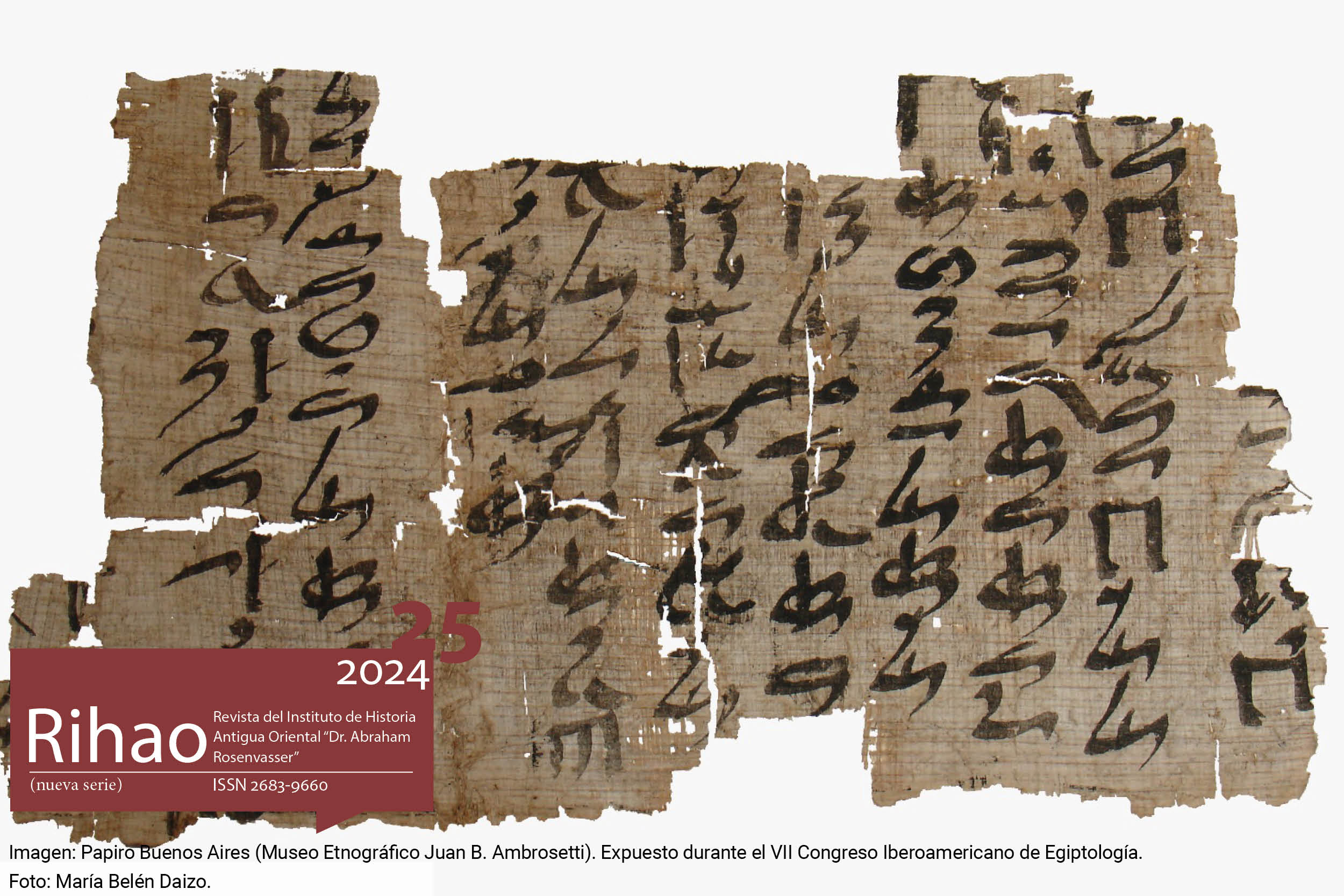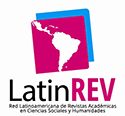Horus Child in the Realm of the Dead: A Study of the Myth in Egyptian Funerary Literature from the Old Kingdom to the New Kingdom
Abstract
In this paper, we will analyze the incorporation of the mythical narrative of the birth and early moments of life of the king-god Horus to funerary literature from the Old Kingdom to the New Kingdom. We will consider the ways it was narrated, the social groups that utilized it, and the general characteristics of the historical contexts in which it was reproduced. The analysis of the processes of edition, appropriation, and adaptation of the episode helps identify changes in symbolic conceptions and sociopolitical practices experienced by Egyptian society throughout its history. Furthermore, the use of the narrative must have been a fundamental element of the legitimizing discourse of the prevailing order in each of the periods considered.Downloads
References
Allen, J. (2005). The Ancient Egyptian Pyramid Texts. Atlanta: Society of Biblical Literature.
Arnold, D. (1997). Temples of Ancient Egypt. Ithaca: Cornell University Press.
Assmann, J. (1977). Die Verborgenheit des Mythos im Ägypten, en: Göttinger Miszellen 25: 7-43.
Assmann, J. (1995). Egipto a la luz de una teoría pluralista de la cultura. Madrid: Akal.
Baines, J. (1999). Forerunners of Narrative Biographies, en: Leahy, A. y Tait, J. (eds.), Studies on Ancient Egypt in Honor of H. S. Smith. Londres: Egypt Exploration Society, 23-37.
Baines, J. y Yoffee, N. (1998). Order, Legitimacy, and Wealth in Ancient Egypt and Mesopotamia, en: Feinman, G. y Marcus, J. (eds.), Archaic States. Santa Fe: School of American Research Press, 199-260.
Bárta, M. (2020). Egypt’s Old Kingdom. A View from Within, en: Radner, K., Moeller, N. y Potts, D. (eds.), The Oxford History of the Ancient Near East, Vol. I, From the Beginnings to Old Kingdom Egypt and the Dynasty of Akkad. Oxford: Oxford University Press, 316-397.
Bassir, H. (2021). Non-Royal Self-Presentation, en: Austin, A. y Wendrich, W. (eds.), UCLA Encyclopedia of Egyptology. Los Ángeles: UCLA. En línea: https://escholarship.org/uc/item/8x15r667. [Consultado: 20-2-2024].
Blázquez Martínez, J. M. (1984). Introducción, en: Blázquez Martínez, J. M. y Lara Peinado, F., El Libro de los Muertos. Madrid: Editora Nacional, 9-67.
Blázquez Martínez, J. M. y Lara Peinado, F. (1984). El Libro de los Muertos. Madrid: Editora Nacional.
Brunner-Traut, E. (2006). Cuentos del Antiguo Egipto. Madrid: Edaf.
Bussmann, R. (2020). Egypt’s Old Kingdom Perspectives on Culture and Society, en: Radner, K., Moeller, N. y Potts, D. (eds.), The Oxford History of the Ancient Near East, Vol. I, From the Beginnings to Old Kingdom Egypt and the Dynasty of Akkad. Oxford: Oxford University Press, 460-530.
Campagno, M. (2004). Una lectura de La contienda entre Horus y Seth. Buenos Aires: Del Signo.
Campagno, M. (2018). Lógicas sociales en el Antiguo Egipto: Diez estudios. Buenos Aires: Editorial de la Facultad de Filosofía y Letras Universidad de Buenos Aires.
Cervelló Autuori, J. (1996). Egipto y África. Origen de la civilización y la monarquía faraónicas en su contexto africano. Barcelona: Ausa.
Cervelló Autuori, J. (2015-2016). A vueltas con la teoría de la “democratización” del más allá tras el Reino Antiguo: algunas ideas, en: Isimu 18-19: 91-102.
Coulon, L. (2004). Rhétorique et stratégies du discours dans les formules funéraires: les innovations des Textes des Sarcophages, en: Bickel, S. y Mathieu, B. (eds.), D’un monde à l’autre. Textes des Pyramides et Textes des Sarcophages. El Cairo: Institut français d’archéologie orientale, 119-142.
Díaz-Iglesias Llanos, L. (2017). Local Reworkings of Core Mythological Notions. The Case of Herakleopolis Magna, en: Bickel, S. y Díaz-Iglesias Llanos, L. (eds.), Studies in Ancient Egyptian Funerary Literature. Lovaina: Peeters, 205-246.
Dorman, P. (2017). The Origins and Early Development of the Book of the Dead, en: Scalf, F. (ed.), Book of the Dead. Becoming God in Ancient Egypt. Chicago: University of Chicago Press, 29-40.
Faulkner, R. (1973). The Ancient Egyptian Coffin Texts. Warminster: Aris & Phillips.
Faulkner, R. (2008 [1994]). The Egyptian Book of the Dead. The Book of Going forth by Day. San Francisco: Chronicle Books.
Frankfort, H. (1998 [1948]). Reyes y dioses. Estudio de la religión del Oriente Próximo en la antigüedad en tanto que integración de la sociedad y la naturaleza. Madrid: Alianza.
Galán, J. (2011). El Reino Nuevo I: La construcción del imperio, en: Parra Ortiz, J. (ed.), El Antiguo Egipto: sociedad, economía, política. Madrid: Marcial Pons, 301-388.
Gnirs, A. (2001). Biographies, en: Redford, D. (ed.), The Oxford Encyclopedia of Ancient Egypt, Vol. I. Oxford: Oxford University Press, 184-189.
Goebs, K. (2002). A Functional Approach to Egyptian Myth and Mythemes, en: Journal of Ancient Near Eastern Religions 2 (1): 27-59.
Goebs, K. (2019). How “Royal” (and “Mythical”) are the Coffin Texts? Reflections on the Definition and Function of Some Etic Concepts in a Middle Kingdom Funerary Text Corpus, en: Nyord, R. (ed.), Concepts in Middle Kingdom Funerary Culture: Proceedings of the Lady Wallis Budge Anniversary Symposium Held at Christ’s College, Cambridge, 22 January 2016. Leiden: Brill, 63-99.
Gracia Zamacona, C. (2006). Un corpus funerario egipcio: los Textos de los Sarcófagos, en: Espacio, Tiempo y Forma. Serie II, Historia Antigua 19: 41-59.
Hart, G. (1991). Pharaohs and Pyramids: A Guide through Old Kingdom Egypt. Londres: Herbert.
Hart, G. (2005). The Routledge Dictionary of Egyptian Gods and Goddesses. Londres: Routledge.
Hornung, E. (1990). El faraón, en: Donadoni, S. (ed.), El hombre egipcio. Madrid: Alianza, 310-339.
Hornung, E. (1999 [1971]). El uno y los múltiples. Concepciones de la divinidad en el Egipto antiguo. Madrid: Trotta.
Hornung, E. (1999). The Ancient Egyptian Books of the Afterlife. Ithaca: Cornell University Press.
Hussein, R. (2013). Recontextualized - The Pyramid Texts ‘Serpent Spells’ in the Saite Contexts, en: Études et Travaux 26: 273-290.
Kemp, B. (2012). How to Read the Egyptian Book of the Dead. Londres: Granta Books.
Klasens, A. (1952). Magical Statue Base (Socle Behague) in the Museum of Antiquities at Leiden. Leiden: Brill.
Lesko, L. (2001). Book of Going Forth by Day, en: Redford, D. (ed.), The Oxford Encyclopedia of Ancient Egypt, Vol. I. Oxford: Oxford University Press, 193-195.
López, F. y Thode, R. (2000-2021). Los Textos de las Pirámides. En línea: https://www.egiptologia.org/pdfs/LosTextosdelasPiramides.pdf. [Consultado: 20-2-2024].
Loprieno, A. (1996). Egyptian Literature. Leiden: Brill.
Morris, E. (2021). The Architecture of Imperialism. Military Bases and the Evolution of Foreign Policy in Egypt’s New Kingdom. Leiden: Brill.
Pinch, G. (2004). Egyptian Myth: A Very Short Introduction. Oxford: Oxford University Press.
Quirke, S. (2001). The Cult of Ra: Sun Worship in Ancient Egypt. Nueva York: Thames & Hudson.
Rundle-Clark, R. (1959). Myth and Symbol in Ancient Egypt. Londres: Thames & Hudson.
Sabbahy, L. (2020). Kingship, Power, and Legitimacy in Ancient Egypt: From the Old Kingdom to the Middle Kingdom. Cambridge: Cambridge University Press.
Scalf, F. (2015). From the Beginning to the End: How to Generate and Transmit Funerary Texts in Ancient Egypt, en: Journal of Ancient Near Eastern Religions 15 (2): 202-223.
Scalf, F. (2017). Introduction: Preparing for the Afterlife in Ancient Egypt, en: Scalf, F. (ed.), Book of The Dead: Becoming God in Ancient Egypt. Chicago: University of Chicago Press, 11-14.
Schenkel, W. (1975). Repères chronologiques de l’histoire rédactionelle des Coffin Texts, en: Posener, G. (ed.), Actes du XXIXe Congrès des Orientalistes: Égyptologie I-II. París: L’Asiathèque, 98-103.
Scott, N. (1951). The Metternich Stela, en: The Metropolitan Museum of Art Bulletin 9 (8): 201-217.
Serrano Delgado, J. (1993). Textos para la Historia Antigua de Egipto. Madrid: Cátedra.
Shirley, J. (2013). Crisis and Restructuring of the State: From the Second Intermediate Period to the Advent of the Ramesses, en: Moreno García, J. C. (ed.), Ancient Egyptian Administration. Leiden: Brill, 521-606.
Silverman, D. (1989). Textual Criticism in the Coffin Texts, en: Simpson, W. (ed.), Religion and Philosophy in Ancient Egypt. New Haven: Yale Egyptological Seminar, 30-33.
Smith, M. (2017). Following Osiris: Perspectives on the Osirian Afterlife from Four Millennia. Oxford: Oxford University Press.
Taylor, J. (2010). Ancient Egyptian Book of the Dead: Journey through the Afterlife. Londres: British Museum Press.
Verner, M. (2001). The Pyramids: A Complete Guide. Nueva York: Grove Press.
Vernus, P. (2005). L’écriture du pouvoir dans l’Égypte pharaonique. Du normatif au performatif, en: Bresson, A., Cocula, A. y Pébarthe, C. (eds.), L’écriture publique du pouvoir. Burdeos: Ausonius, 123-142.
Volokhine, Y. (2018). À propos de la construction d’un débat sur les mythes égyptiens, en: Revue de l’histoire des religions 4: 619-644.
von Lieven, A. (2019). How “funerary” are the Coffin Texts?, en: Nyord, R. (ed.), Concepts in Middle Kingdom Funerary Culture: Proceedings of the Lady Wallis Budge Anniversary Symposium Held at Christ’s College, Cambridge, 22 January 2016. Leiden: Brill, 100-116.
Willems, H. (2014). Historical and Archaeological Aspects of Egyptian Funerary Culture: Religious Ideas and Ritual Practice in Middle Kingdom Elite Cemeteries. Leiden: Brill.
Copyright (c) 2024 Bárbara Hofman

This work is licensed under a Creative Commons Attribution-NonCommercial 4.0 International License.





.jpg)







